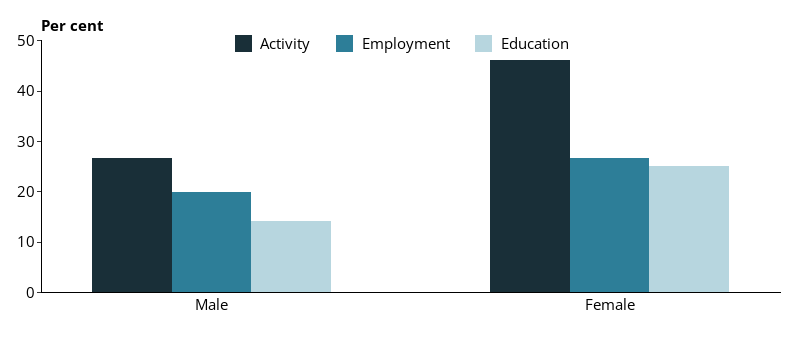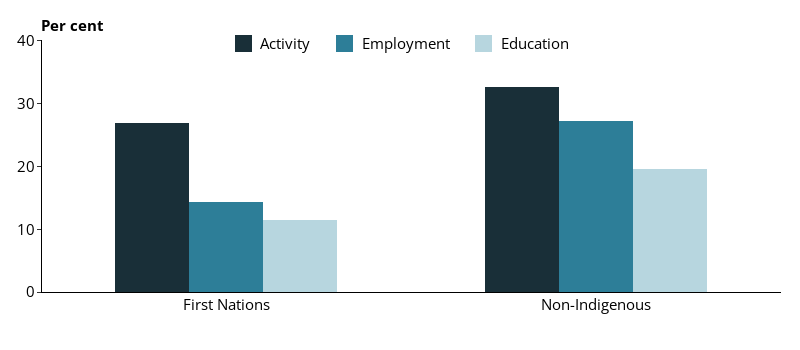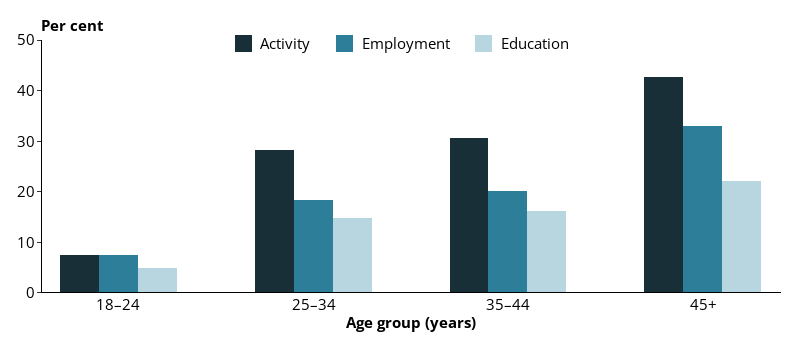Health conditions or disabilities that affect everyday activities
Any limitation
Prison entrants were asked whether they had a long-term health condition or disability that affected their participation in education, employment or everyday activities.
Almost 2 in 5 (39%) prison entrants reported that a long-term health condition or disability affected their participation in everyday activities (30%), education (16%) or employment (21%) (Indicator 1.3.1).
Almost a half (47%) of female prison entrants reported a limitation in everyday activities, 25% in education, and 27% in employment, while more than one-quarter (27%) of male prison entrants reported a limitation in everyday activities, 14% in education and 20% in employment (Figure 4.1).
Figure 4.1: Prison entrants, self-reported chronic health condition or disability limiting their participation in activities, education or employment, by sex and type of limitation, 2022

Notes
- Proportions are representative of this data collection only, and not the entire prison population.
- Excludes Victoria, which did not provide data for this item.
Source: Entrants form, 2022 NPHDC.
Non-Indigenous prison entrants were more likely to report restrictions to activity (33%), education (20%) and employment (27%) than First Nations prison entrants (27%,12% and 14%, respectively) (Figure 4.2).
Figure 4.2: Prison entrants, self-reported chronic health condition or disability limiting their participation in activities, education, or employment, by Indigenous identity and type of limitation, 2022

Notes
- Proportions are representative of this data collection only, and not the entire prison population.
- Excludes Victoria, which did not provide data for this item.
Source: Entrants form, 2022 NPHDC.
The prevalence of self-reported limitations to everyday activities, education or employment increased with age, from 1 in 8 (12%) prison entrants aged 18–24 to over 1 in 2 (55%) for entrants aged 45 and over. Increasing prevalence in limitations with age was consistent across everyday activities, education and employment (Figure 4.3).
Figure 4.3: Prison entrants, self-reported chronic health condition or disability limiting their participation in activities, education or employment, by age and type of limitation, 2022

Notes
- Proportions are representative of this data collection only, and not the entire prison population.
- Excludes Victoria, which did not provide data for this item.
Source: Entrants form, 2022 NPHDC.
Comparisons with the general community
In 2018, nearly 1 in 5 (18%) Australians of all ages had disability (ABS 2019). This compares with almost 2 in 5 (39%) prison entrants aged 18 and over in the 2022 NPHDC.
Comparisons of the prevalence of disability between the prison population and adults in the general community are difficult, as people in prison are typically younger than those in the community, and the prevalence of many types of disability, particularly core activity limitations, increases with age. People in prison also experience accelerated ageing, which may predispose them to health conditions that are more prevalent among older populations (AIHW 2020).
Disability prevalence increases with age
The prevalence of disability among prison entrants is higher in each age bracket than in the general community:
- Of those aged 25–34, 1 in 14 (7.1%) people in the community, and 1 in 3 (36%) prison entrants reported a disability.
- Of those aged 35–44, 1 in 11 (9.0%) people in the community, and 2 in 5 (39%) prison entrants reported a disability.
- Of those aged 45–54, 1 in 6 (16%) people in the community, and half (49%) of prison entrants reported a disability (ABS 2019).
Core activity limitations
Core activity limitations are those that affect a person’s ability to undertake the ‘core activities’ of self-care, mobility, and/or communication – activities deemed to be essential to normal everyday living.
Limitations in the areas of self-care, mobility and/or communication were combined to form the ‘core activity limitation’ indicator.
People living with disability can also be identified as having schooling and/or employment restrictions. If a person does not have any core activity limitations, or any schooling/employment restrictions, they can still be living with disability if they have identified limitations or restriction with other activities; in this case, they are classified as having the lowest severity of disability (ABS 2019).
Of prison entrants surveyed, 9.4% reported profound or severe core activity limitations (Indicator 1.3.2).
About 1 in 20 (4.9%) prison entrants reported moderate core activity limitations and 1.3% reported mild core activity limitations.
Of the 16% of entrants reporting any core limitation, almost 2 in 3 (60%) rated the limitation as profound/severe, about 1 in 3 (31%) as moderate, and almost 1 in 10 (8.6%) as mild.
Comparisons with the general community
The prevalence of profound or severe core activity limitations among people aged 18–34 in the general community was 2.1% while the prevalence among people of the same age in prison was 4.9% (AIHW analysis of ABS 2022).
Among people aged 35–54 in the community, 2.8% reported having profound or severe core activity limitations while 13% of people of the same age in prison reported having profound or severe core activity limitations.
Female prison entrants aged 18 and over were more than twice as likely to report having profound or severe core activity limitations (17%) as females of the same age in the general community (7.0%).
Males prison entrants aged 18 and over were similarly as likely to report profound or severe core activity limitations (8.0%) as those of the same age in the community (5.7%). However, these results will be affected by the different age profile of prison entrants and people in the community. Prison entrants are predominantly younger (aged 25–44) than adults in the community. People in prison also experience accelerated ageing, meaning that people aged 45 and over can be considered elderly in prison (Baidawi et al. 2011; Turner and Trotter 2010).
Australian Bureau of Statistics (ABS) (2019) Disability, ageing and carers, Australia: summary of findings, 2018, ABS website, accessed 3 May 2023.
——(2022), Disability and carers: Census, ABS Website, accessed 9 October 2023.
AIHW (Australian Institute of Health and Welfare) (2020) Health and ageing of Australia's prisoners 2018, AIHW, Australian Government, accessed 03 October 2023.
Baidawi S, Turney S, Trotter C, Browning C, Collier P, O’Connor D and Sheehan R (2011) ‘Older prisoners: a challenge for Australian corrections’, Trends and Issues in Crime and Criminal Justice, Australian Institute of Criminology, Canberra, 426. (2021), Disability and carers: Census, ABS Website, accessed 9 October 2023.
Turner S and Trotter C (2010) Growing old in prison? – a review of national and international research on ageing offenders, report prepared for Corrections Victoria, Corrections Research Paper Series, paper no. 03, Department of Justice, Melbourne, Victoria.


